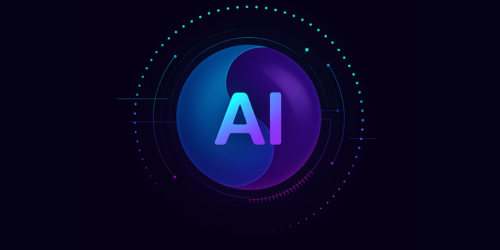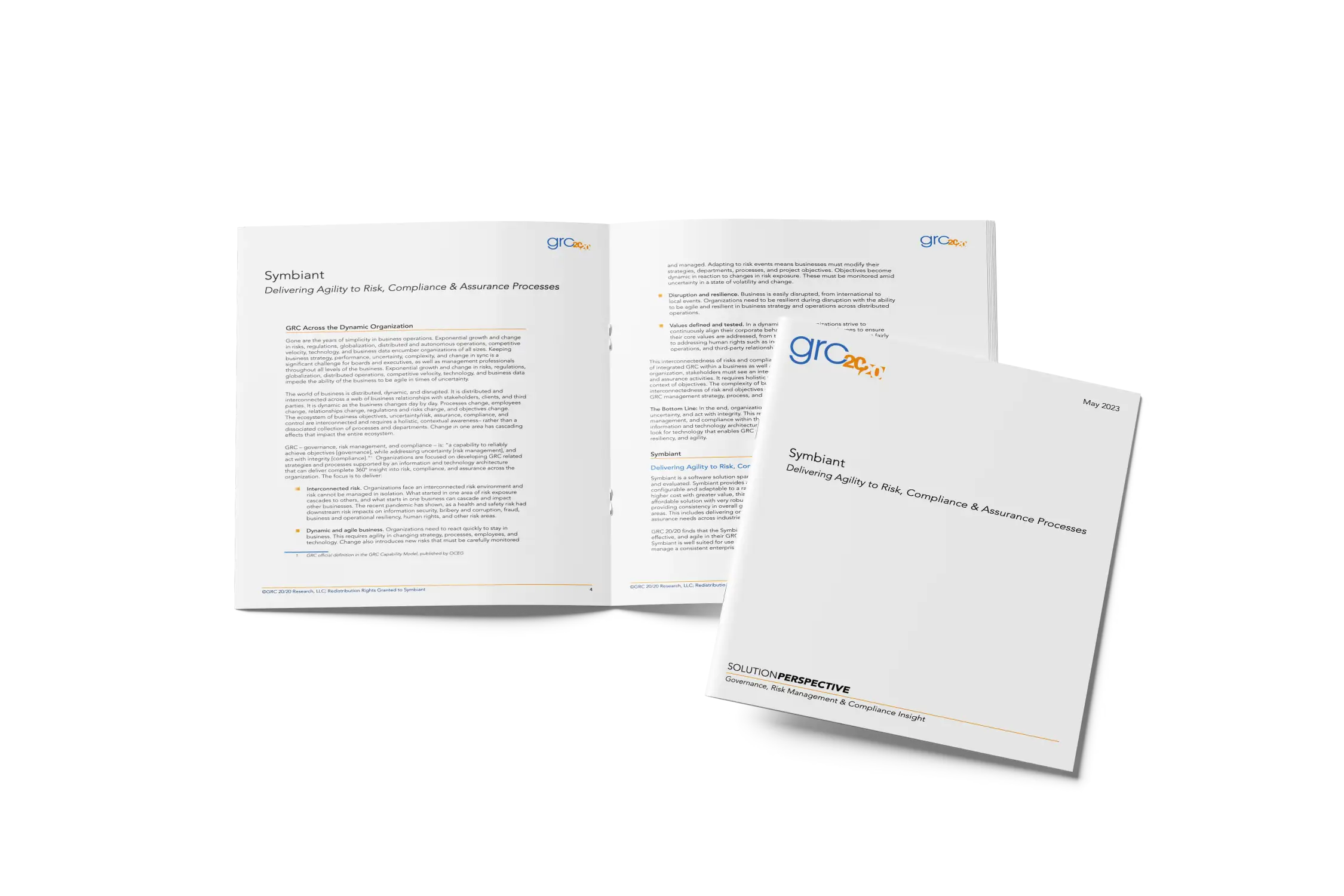GRC, Risk Management & Audit platform
GRC Software: Governance, Risk Management, Compliance and Audit Solutions to Achieve Objectives, Build Resilience, and Ensure Compliance
Discover how Symbiant’s highly trusted, agile, and fully customisable GRC and Audit software helps organisations manage governance, risk, compliance, and audit with ease. Our AI-enhanced, modular, and affordable platform consolidates data into a single source of truth, strengthens the second line of defence (2LoD), improves reporting, and scales effortlessly as you grow.
Award-Winning GRC & Audit Software,
Highly Trusted Since 1999 by

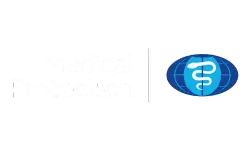







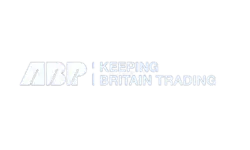























The Rapid Growth of the GRC Software Market
Why Organisations Worldwide Are Adopting Governance, Risk and Compliance (GRC) Software
As a business professional, staying informed about the evolving landscape of governance, risk management, and compliance is essential. According to WorldMetrics.org, the global Governance, Risk and Compliance (GRC) software market is projected to surge to USD 55.9 billion by 2027, growing at a 10.4% CAGR from 2020 to 2027. This growth is more than a trend — it reflects the urgent need for organisations to strengthen compliance, improve governance, and manage risks more effectively. GRC software is not just a tool; it is a strategic solution that enhances data management, strengthens the second line of defence (2LoD), and enables a holistic approach to risk and compliance.
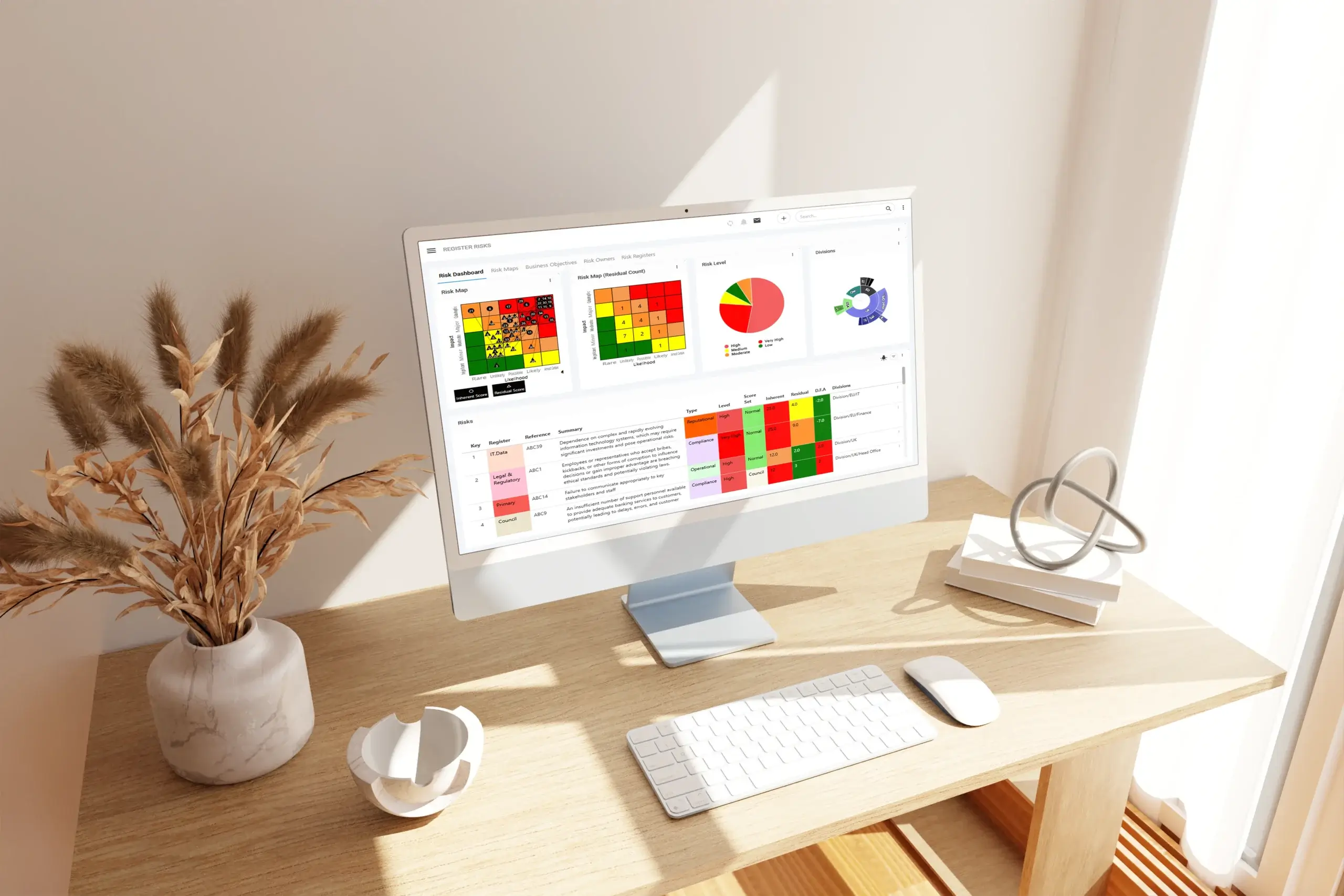
The Rapid Growth of the GRC Software Market
What is GRC Software? (Governance, Risk and Compliance Explained)
GRC software stands for Governance, Risk and Compliance software. It provides an integrated framework that unifies governance structures, risk management processes, and compliance controls across the organisation. Instead of treating these areas separately, GRC software consolidates them into a Single Source of Truth (SSOT), ensuring consistency, accountability, and efficiency across the organisation.
At its core, GRC is built on three pillars:
Governance – aligning business strategy, policies, and leadership structures with corporate objectives.
Risk management – identifying, assessing, and mitigating risks that could disrupt operations or compliance. ISO 31000 defines risk as “the effect of uncertainty on objectives.” This definition is more than just wording — it provides a practical blueprint for action. Risk is not simply a catalogue of potential negative events; it is the uncertainty that can influence an organisation’s ability to perform, achieve its goals, and grow.
Compliance – meeting legal, regulatory, and internal policy requirements to avoid penalties and reputational damage.
GRC software brings these pillars together in one centralised system, combining tools such as risk registers, compliance monitoring, and audit management. By consolidating activities, it eliminates silos, improves transparency, and ensures risk management is directly linked to business objectives. This helps organisations strengthen accountability, achieve certifications like ISO 27001 and GDPR compliance, and build long-term resilience.
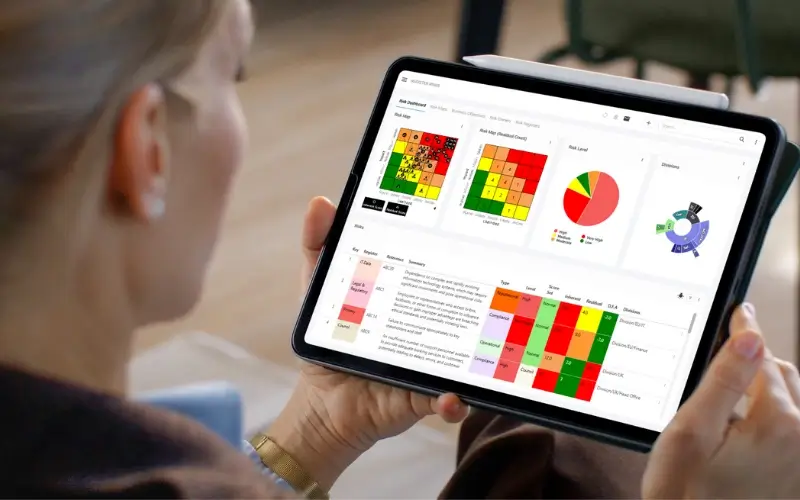
Customisable, Scalable ISO 31000 Risk Management Software
Key Components of an Effective GRC Framework
Governance: Building the Foundation for Oversight and Accountability
Governance: The Foundation of Oversight and Strategic Alignment
Governance is the cornerstone of an effective GRC framework. It provides the structure, policies, and leadership that guide both risk management and compliance activities, ensuring they remain aligned with organisational strategy and objectives. Strong governance establishes a culture of accountability and transparency, creating the foundation for informed decision-making and long-term resilience.
An effective governance framework includes:
Leadership accountability – assigning clear responsibilities and ownership for executives, risk managers, and compliance officers to ensure oversight at every level.
Ethical governance – policies and codes of conduct that support responsible decision-making, regulatory alignment, and organisational integrity.
Performance oversight – regular board-level reporting on risks, compliance outcomes, and assurance activities to support transparency.
Strategic alignment – ensuring that governance policies and controls directly support business goals, risk appetite, and regulatory obligations.
Continuous improvement – monitoring performance metrics and adapting governance frameworks to evolving risks and compliance requirements.
By strengthening governance, organisations can ensure risk and compliance are not just protective measures, but enablers of performance, accountability, and trust.
Risk Management: Proactively Identifying and Addressing Uncertainty
Risk management is not only about avoiding threats — it is about enabling performance and growth in the face of uncertainty. According to ISO 31000, risk is defined as “the effect of uncertainty on objectives.” A mature risk management framework helps organisations anticipate, assess, and treat risks before they disrupt operations or compliance, ensuring risks are managed in context with business goals.
An effective risk management strategy includes:
Enterprise-wide risk assessments – evaluating financial, operational, strategic, and cyber risks across the organisation to build a complete risk profile.
Treatment and control plans – implementing safeguards, controls, and mitigations to prevent risks from escalating into compliance failures or operational disruptions.
Response and recovery strategies – ensuring preparedness for cyber incidents, fraud, regulatory changes, supply chain disruption, or market volatility.
Dynamic risk monitoring – using GRC software to continuously track risks, update scoring, and provide real-time visibility to leadership.
Integration with objectives – linking risks directly to strategic and operational business objectives, ensuring decisions are informed by risk context.
By adopting a proactive, ISO 31000-aligned approach, organisations transform risk management from a defensive function into a driver of resilience, accountability, and long-term success.
Compliance: Strengthening Regulatory Assurance and Ethical Culture
Compliance is about more than ticking boxes, it safeguards organisations against legal penalties, regulatory breaches, and reputational damage while embedding a culture of ethics and accountability. With regulations such as ISO 27001, GDPR, and Cyber Essentials continuously evolving, a strong compliance framework ensures organisations remain agile, accurate, and audit-ready.
Core elements of effective compliance include:
Regulatory mapping and monitoring – tracking laws, industry standards, and internal policies to maintain compliance across multiple frameworks.
Automated compliance controls – leveraging GRC software to streamline testing, reduce manual effort, and improve accuracy in monitoring.
Awareness and training – equipping employees with the knowledge and tools they need to meet compliance obligations and follow ethical standards.
Audit readiness – maintaining evidence, audit trails, and consistent reporting to demonstrate compliance at any time.
Continuous assurance – ensuring compliance is monitored regularly, reducing the risk of oversight or outdated practices.
By strengthening compliance processes, organisations not only reduce risk exposure but also build stakeholder confidence, improve efficiency, and foster a culture of ethical governance and transparency.
Integrating Governance, Risk and Compliance
A successful GRC framework integrates governance, risk management, and compliance into a single, cohesive structure. When aligned, these elements:
Reduce risk exposure.
Improve efficiency and decision-making.
Strengthen resilience and accountability.
Enhance trust with regulators, stakeholders, and customers.
With Symbiant’s modular and AI-enhanced GRC & Audit platform, organisations can put these principles into practice effortlessly, embedding governance, managing risks, and automating compliance in one trusted system.
Benefits of GRC Software for Businesses of All Sizes
GRC, Risk Management and Audit software delivers measurable value for organisations across industries and sectors. Whether you are a small business a charity, or a global enterprise, the advantages of GRC software are clear:
Centralises governance, risk and compliance into one integrated platform.
Improves efficiency by replacing manual spreadsheets with automated workflows.
Strengthens accountability through clear roles, audit trails, and transparent reporting.
Reduces regulatory risk by aligning policies and controls with compliance standards.
Supports growth by scaling seamlessly as the organisation expands.
Delivers cost savings with affordable pricing and streamlined processes.
How GRC Software Enhances Risk Management and Business Objectives
ISO 31000 defines risk as “the effect of uncertainty on objectives.” Risk management is therefore about more than avoiding threats, it is about enabling performance and growth despite uncertainty.
Symbiant’s agile, award-winning and highly trusted GRC and Audit software enhances risk management by:
Providing dynamic risk registers to capture, score, and monitor risks.
Linking risks directly to business objectives so impact and context are always visible.
Supporting ISO 31000 frameworks, ensuring structured identification, assessment, treatment, and monitoring.
Offering real-time visibility into risks so leadership can make informed decisions.
By connecting risk to objectives, GRC software enables organisations to protect performance while achieving growth.
How GRC Software Improves Compliance and Regulatory Assurance (ISO 27001, GDPR, Cyber Essentials)
Compliance is a constant challenge, with organisations often needing to meet multiple frameworks at once. GRC compliance software simplifies this by:
ISO 27001 compliance – generating Statements of Applicability, managing control testing, and documenting evidence.
GDPR compliance – centralising DPIAs and maintaining audit trails.
Cyber Essentials compliance – ensuring security controls are monitored and tested regularly.
Providing regulatory assurance with consistent evidence, audit readiness, and defensible records.
This makes it easier for organisations to demonstrate compliance, pass audits, and maintain stakeholder confidence.
Real-Time Data, Analytics and Reporting in GRC Software
Effective governance and risk management depend on accurate, up-to-date information. GRC software improves reporting and analytics by:
Consolidating data into a Single Source of Truth (SSOT).
Breaking down silos with full data integration across departments.
Offering real-time dashboards and risk reporting.
Improving reporting accuracy through automation and reduced errors.
Providing customisable reports for regulators, boards, or stakeholders.
With real-time management information (MI), organisations can anticipate risks instead of reacting late.
What is the Second Line of Defence (2LoD) and How GRC Software Supports It
In risk management, the second line of defence (2LoD) provides oversight of operational risks managed by the first line. It typically includes risk, compliance, and quality assurance functions.
GRC software strengthens the 2LoD by:
Enabling continuous monitoring of risks, compliance tasks, and incidents.
Providing assurance tools to track control effectiveness.
Supporting internal audit coordination with clear data flows to the third line.
Offering real-time oversight dashboards for executive visibility.
Transparency, Audit Trails and Accountability with GRC Software
Accountability is a cornerstone of effective governance. GRC audit trail software ensures:
Every change and decision is fully recorded.
Traceability of risks, incidents, and actions across the organisation.
Audit readiness with defensible records available at any time.
Assurance for management, regulators, and stakeholders that controls are effective.
This transparency builds trust and confidence across the organisation and beyond.
A Holistic Approach to Governance, Risk and Compliance Management
GRC software enables a holistic risk management approach by connecting governance, risk, compliance, and audit in one platform. Benefits include:
Identifying interdependencies between risks and controls.
Improving organisational resilience by managing threats in context.
Encouraging collaboration across departments instead of silos.
Supporting enterprise risk management (ERM) with consistent oversight.
This integrated GRC approach ensures organisations can adapt, grow, and perform sustainably.
GRC vs ERM: Shared Foundations, Different Focus
A common question from organisations is whether Governance, Risk and Compliance (GRC) and Enterprise Risk Management (ERM) are the same. While both approaches are built on the same fundamental risk management principles, they are applied in different ways depending on business needs and regulatory demands.
Enterprise Risk Management (ERM) takes an enterprise-wide perspective, bringing together all categories of risk, from financial and operational to cyber, strategic, and compliance, under a single, unified risk strategy.
Governance, Risk and Compliance (GRC) provides the framework, structure, and tools to put those ERM principles into practice. It ensures risks are managed consistently, compliance obligations are met, and governance supports organisational objectives.
In practice, ERM sets the strategic direction for risk management, while GRC delivers the operational framework and accountability that makes it actionable. When combined, they enable organisations to strengthen resilience, improve decision-making, and align risk and compliance with long-term objectives.
Do All Companies Need GRC Software?
The short answer is yes, every organisation, regardless of size, industry, or regulatory environment, benefits from having governance, risk, and compliance practices in place.
Large enterprises face complex frameworks, multi-jurisdictional regulations, and extensive reporting requirements. For them, GRC software provides the structure to manage enterprise-wide risk, standardise compliance processes, and maintain accountability across business units.
Small and medium-sized businesses (SMEs) may not have dedicated risk or compliance teams, but they still need to address growing challenges such as GDPR compliance, Cyber Essentials certification, financial controls, and cybersecurity risks. Without proper governance, these risks can quickly escalate into fines, reputational damage, or operational disruption.
Symbiant makes GRC accessible to all organisations. With an affordable, modular, and fully customisable platform, you can start small, focus on the modules you need most, and scale effortlessly as your business grows. This ensures that governance, risk management, and compliance are not just obligations but practical enablers of performance, resilience, and growth.
Hover to Explore our Solutions.
Symbiant
All-in-One GRC & Audit
Management Powerhouse
Symbiant’s flexible, modular platform streamlines governance, risk, compliance, and audit—so you can reduce complexity, adapt fast, and stay focused on achieving your objectives.
Our Solution at a Glance:
Risk Management Software
The Symbiant Risk Management Software module enables organisations to identify, understand, and manage risks with ease and efficiency. It provides a streamlined approach to monitoring, assessing, and mitigating risks, ensuring informed decisions and compliance.
AI-Powered Assistant
Symbiant AI connects data across your organisation, delivering actionable insights and seamless workflows. From logical, data-driven risk scoring to uncovering root causes and predicting the domino effect of control failures, Symbiant AI empowers smarter, faster decisions. Eliminate duplicate risks in seconds, refine controls, identify emerging risks, and so much more—all tailored to your business.
Audit Management Software
The Symbiant Audit Management Software module streamlines audit planning, action tracking, and time management. It automatically pulls relevant data, allows easy report customisation, and generates professional audit reports.
Compliance Management Software
The Symbiant Compliance Management Software module simplifies the management of compliance tasks. It helps organisations track regulations, manage audits, and ensure adherence to legal requirements, driving efficiency and minimising risk.
Risk Management Software
The Symbiant Risk Management Software module enables organisations to identify, understand, and manage risks with ease and efficiency. It provides a streamlined approach to monitoring, assessing, and mitigating risks, ensuring informed decisions and compliance.
AI-Powered Assistant
Symbiant AI connects data across your organisation, delivering actionable insights and seamless workflows. From logical, data-driven risk scoring to uncovering root causes and predicting the domino effect of control failures, Symbiant AI empowers smarter, faster decisions. Eliminate duplicate risks in seconds, refine controls, identify emerging risks, and so much more—all tailored to your business.
Audit Management Software
The Symbiant Audit Management Software module streamlines audit planning, action tracking, and time management. It automatically pulls relevant data, allows easy report customisation, and generates professional audit reports.
Compliance Management Software
The Symbiant Compliance Management Software module simplifies the management of compliance tasks. It helps organisations track regulations, manage audits, and ensure adherence to legal requirements, driving efficiency and minimising risk.

Your Central Hub for GRC, Risk, Audit & Compliance Excellence
Discover More in Symbiant’s GRC Knowledge Centre
Looking for even more insights, tools, and practical guidance? Visit the Symbiant GRC Knowledge Centre, your all-in-one hub for governance, risk, compliance (GRC), and audit resources.
Explore our guides, in-depth glossary definitions, industry-specific best practices, and demonstration videos, all organised by industry, organisation size, and compliance framework (including ISO 27001, GDPR, Cyber Essentials, and more).
Whether you’re a charity, SME, or global enterprise, you’ll find tailored content to help you streamline processes, strengthen compliance, and achieve your business objectives, all backed by Symbiant’s award-winning, enterprise-grade GRC, Risk Management & Audit software.




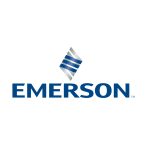

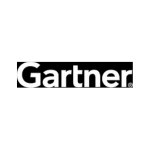

Award winning grc & Audit management software
25 Years. Thousands of Users. One Trusted Platform.
With over 25 years of innovation in Governance, Risk, and Compliance (GRC) and Audit Management, Symbiant is trusted by organisations across every sector. Our clients love how our powerful, affordable, award-winning and fully customisable risk software helps them stay compliant, make smarter decisions, and reduce complexity, without the costly overheads.
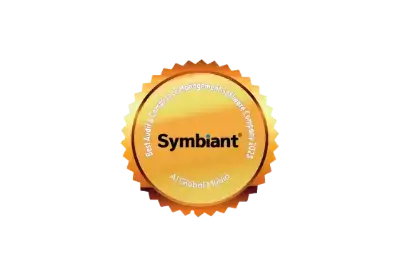

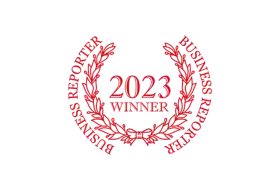
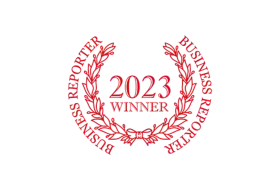





unbeatable pricing

